2020年ACCA几月份报名?哪些人可以申请免试科目?
发布时间:2020-03-04
随着新年的到来,一些ACCA学员也开始在网上查询考试的相关信息。ACCA考试每年举行四次,因此有关考试报名时间以及免考条件就是部分新学员所关心的问题。鉴于此,51题库考试学习网在下面为大家带来ACCA考试免试条件及报名时间的相关情况,以供参考。
ACCA考试报名时间比较自由,分为提前、常规、后期三个时间段,越往后报名费用越高。考生可在ACCA官网查询不同考试季提前报名的具体截止时间。
ACCA考试免试条件比较多:已获得注册会计师资格的考生可免试部分ACCA考试科目:注册会计师考生免试条件:
一、2009年CICPA“6+1”新制度实行之前获得CICPA全科通过的人员:免试5门课程(F1-F4和F6)
二、2009年CICPA“6+1”新制度实行之后获得CICPA全科通过的人员:免试9门课程(F1-F9)
三、如果在学习ACCA基础阶段科目的过程中获得了CICPA全科合格证(须2009年“6+1”制度实行后的新版证书),可以自行决定是否申请追加免试。(具体申请方法要以ACCA官方规定为准)
除了注册会计师外,ACCA对中国教育部认可的全日制大学在读生(会计或金融专业)也设置了以下免试政策:
一、会计学或金融学(完成第一学年课程):可以注册为ACCA正式学员,无免试
二、会计学或金融学(完成第二学年课程):免试3门课程(F1-F3)(需要所有课程合格)
三、会计学或金融学(完成第三学年课程):免试5门课程(F1-F5)(要求同上)
四、其他专业(在校生完成大一后):可以注册但无免试(以上免试政策均仅针对本科在校生)
除了在校生外,ACCA对中国教育部认可高校毕业生也设置有免试政策:
一、会计学(获得学士学位):免试5门课程(F1-F5)(需全部课程合格)
二、会计学(辅修专业):免试3门课程(F1-F3)(同上)
三、金融专业:免试5门课程(F1-F5)(要求同上)
四、法律专业:免试1门课程(F4)(要求同上)
五、商务及管理专业:免试1门课程(F1)(要求同上)
六、MPAcc专业(获得MPAcc学位或完成MPAcc大纲规定的所有课程、只有论文待完成):原则上免试九门课程(F1–F9),不过其中F6(税务)另有免试条件:CICPA全科通过或MPAcc课程中选修了“中国税制”课程。
七、MBA学位(获得MBA学位):免试3门课程(F1-F3)
八、非相关专业:无免试
除了以上这些外,ACCA还有这些免试条件:
一、CMA(美国注册管理会计师)全科通过并取得证书:免试F1-F3
二、USCPA(美国注册会计师)全科通过:免试F1-F6、F8、F9(共免8门)
以上就是关于ACCA考试免考条件的相关内容。51题库考试学习网提醒:虽然ACCA考试能够免试部分科目,但是免试科目也要缴纳与报名费一致的免试费,请各位小伙伴注意。最后,51题库考试学习网预祝准备参加2020年ACCA考试的小伙伴都能顺利通过。
下面小编为大家准备了 ACCA考试 的相关考题,供大家学习参考。
(c) non-consolidated entities under common control. (4 marks)
(c) Non-consolidated entities under common control
■ Horizontal groups of entities under common control were a significant feature of the Enron and Parmalat business
empires.
■ Such business empires increase audit risk as fraud is often disguised through labyrinthine group structures. Hence
auditors need to understand and confirm the economic purpose of entities within business empires (as well as special
purpose entities (SPEs) and non-trading entities).
■ Horizontal groups fall outside the requirement for the preparation of group accounts. It is not only finance that is offbalance
sheet when controlled entities are excluded from consolidated financial statements.
■ In the absence of consolidated financial statements, users of accounts of entities in horizontal groups have to rely on the
disclosure of related party transactions and control relationships for information about transactions and arrangements
with other group entities. Difficulties faced by auditors include:
? failing to detect related party transactions and control relationships;
? not understanding the substance of transactions with entities under common control;
? excessively creative tax planning;
? the implications of transfer pricing (e.g. failure to recognise profits unrealised at the business empire level);
? a lack of access to relevant confidential information held by others;
? relying on representations made in good faith by those whom the auditors believe manage the company when
control rests elsewhere.
■ Audit work is inevitably increased if an auditor is put upon inquiry to investigate dubious transactions and arrangements.
However, the complexity of business empires across multiple jurisdictions with different auditors may deter auditors from
liaising with other auditors (especially where legal or professional confidentiality considerations prevent this).
1 Alvaro Pelorus is 47 years old and married to Maria. The couple have two children, Vito and Sophie, aged 22 and
19 years respectively. Alvaro and Maria have lived in the country of Koruba since 1982. On 1 July 2005 the family
moved to the UK to be near Alvaro’s father, Ray, who was very ill. Alvaro and Maria are UK resident, but not ordinarily
resident in the tax years 2005/06 and 2006/07. They are both domiciled in the country of Koruba.
On 1 February 2007 Ray Pelorus died. He was UK domiciled, having lived in the UK for the whole of his life. For the
purposes of inheritance tax, his death estate consisted of UK assets, valued at £870,000 after deduction of all
available reliefs, and a house in the country of Pacifica valued at £94,000. The executors of Ray’s estate have paid
Pacifican inheritance tax of £1,800 and legal fees of £7,700 in respect of the sale of the Pacifican house. Ray left
the whole of his estate to Alvaro.
Ray had made two gifts during his lifetime:
(i) 1 May 2003: He gave Alvaro 95 acres of farm land situated in the UK. The market value of the land was
£245,000, although its agricultural value was only £120,000. Ray had acquired the land on
1 January 1996 and granted an agricultural tenancy on that date. Alvaro continues to own the
land as at today’s date and it is still subject to the agricultural tenancy.
(ii) 1 August 2005: He gave Alvaro 6,000 shares valued at £183,000 in Pinger Ltd, a UK resident trading
company. Gift relief was claimed in respect of this gift. Ray had acquired 14,000 shares in
Pinger Ltd on 1 April 1997 for £54,600.
You may assume that Alvaro is a higher rate taxpayer for the tax years 2005/06 and 2006/07. In 2006/07 he made
the following disposals of assets:
(i) On 1 July 2006 he sold the 6,000 shares in Pinger Ltd for £228,000.
(ii) On 1 September 2006 he sold 2,350 shares in Lapis Inc, a company resident in Koruba, for £8,270. Alvaro
had purchased 5,500 shares in the company on 1 September 2002 for £25,950.
(iii) On 1 December 2006 he transferred shares with a market value of £74,000 in Quad plc, a UK quoted company,
to a UK resident discretionary trust for the benefit of Vito and Sophie. Alvaro had purchased these shares on
1 January 2006 for £59,500.
Alvaro has not made any other transfers of value for the purposes of UK inheritance tax. He owns the family house
in the UK as well as shares in UK and Koruban companies and commercial rental property in the country of Koruba.
Maria has not made any transfers of value for the purposes of UK inheritance tax. Her only significant asset is the
family home in the country of Koruba.
Alvaro and his family expect to return to their home in the country of Koruba in October 2007 once Ray’s affairs have
been settled. There is no double taxation agreement between the UK and Koruba.
Required:
(a) Calculate the inheritance tax (IHT) payable as a result of the death of Ray Pelorus. Explain the availability
or otherwise of agricultural property relief and business property relief on the two lifetime gifts made by Ray.
(8 marks)
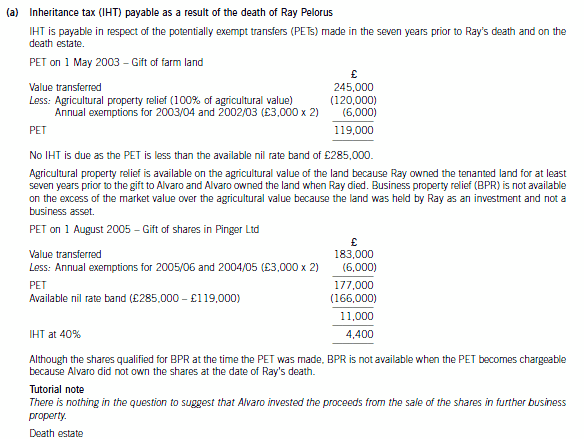
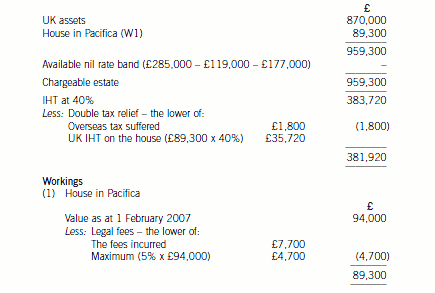
(b) (i) Discusses the principles involved in accounting for claims made under the above warranty provision.
(6 marks)
(ii) Shows the accounting treatment for the above warranty provision under IAS37 ‘Provisions, Contingent
Liabilities and Contingent Assets’ for the year ended 31 October 2007. (3 marks)
Appropriateness of the format and presentation of the report and communication of advice. (2 marks)
(b) Provisions – IAS37
An entity must recognise a provision under IAS37 if, and only if:
(a) a present obligation (legal or constructive) has arisen as a result of a past event (the obligating event)
(b) it is probable (‘more likely than not’), that an outflow of resources embodying economic benefits will be required to settle
the obligation
(c) the amount can be estimated reliably
An obligating event is an event that creates a legal or constructive obligation and, therefore, results in an enterprise having
no realistic alternative but to settle the obligation. A constructive obligation arises if past practice creates a valid expectation
on the part of a third party. If it is more likely than not that no present obligation exists, the enterprise should disclose a
contingent liability, unless the possibility of an outflow of resources is remote.
The amount recognised as a provision should be the best estimate of the expenditure required to settle the present obligation
at the balance sheet date, that is, the amount that an enterprise would rationally pay to settle the obligation at the balance
sheet date or to transfer it to a third party. This means provisions for large populations of events such as warranties, are
measured at a probability weighted expected value. In reaching its best estimate, the entity should take into account the risks
and uncertainties that surround the underlying events.
Expected cash outflows should be discounted to their present values, where the effect of the time value of money is material
using a risk adjusted rate (it should not reflect risks for which future cash flows have been adjusted). If some or all of the
expenditure required to settle a provision is expected to be reimbursed by another party, the reimbursement should be
recognised as a separate asset when, and only when, it is virtually certain that reimbursement will be received if the entity
settles the obligation. The amount recognised should not exceed the amount of the provision. In measuring a provision future
events should be considered. The provision for the warranty claim will be determined by using the expected value method.
The past event which causes the obligation is the initial sale of the product with the warranty given at that time. It would be
appropriate for the company to make a provision for the Year 1 warranty of $280,000 and Year 2 warranty of $350,000,
which represents the best estimate of the obligation (see Appendix 2). Only if the insurance company have validated the
counter claim will Macaljoy be able to recognise the asset and income. Recovery has to be virtually certain. If it is virtually
certain, then Macaljoy may be able to recognise the asset. Generally contingent assets are never recognised, but disclosed
where an inflow of economic benefits is probable.
The company could discount the provision if it was considered that the time value of money was material. The majority of
provisions will reverse in the short term (within two years) and, therefore, the effects of discounting are likely to be immaterial.
In this case, using the risk adjusted rate (IAS37), the provision would be reduced to $269,000 in Year 1 and $323,000 in
Year 2. The company will have to determine whether this is material.
Appendix 1
The accounting for the defined benefit plan is as follows:
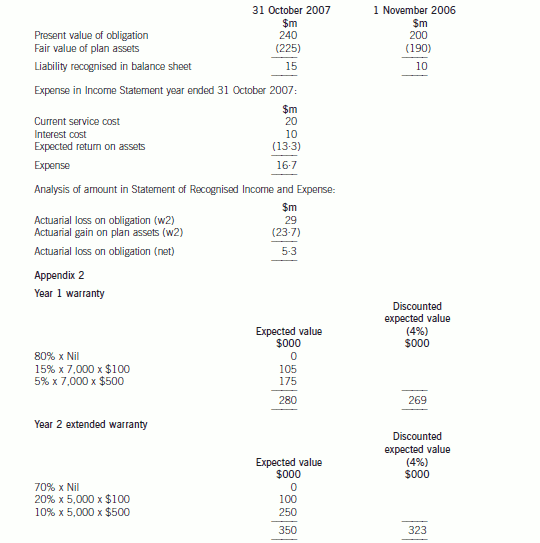
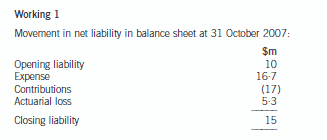
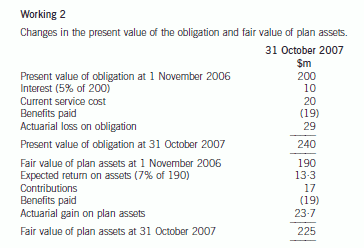
声明:本文内容由互联网用户自发贡献自行上传,本网站不拥有所有权,未作人工编辑处理,也不承担相关法律责任。如果您发现有涉嫌版权的内容,欢迎发送邮件至:contact@51tk.com 进行举报,并提供相关证据,工作人员会在5个工作日内联系你,一经查实,本站将立刻删除涉嫌侵权内容。
- 2020-04-16
- 2020-01-10
- 2020-01-09
- 2020-01-10
- 2020-04-07
- 2020-04-21
- 2020-01-10
- 2020-01-10
- 2020-03-12
- 2020-04-17
- 2020-03-27
- 2020-04-24
- 2020-03-03
- 2020-01-09
- 2020-02-21
- 2020-03-11
- 2020-02-29
- 2019-07-21
- 2020-03-04
- 2020-02-28
- 2020-02-28
- 2020-03-20
- 2020-01-10
- 2020-02-22
- 2021-04-23
- 2020-01-10
- 2020-03-20
- 2020-01-31
- 2020-01-09
- 2020-01-10